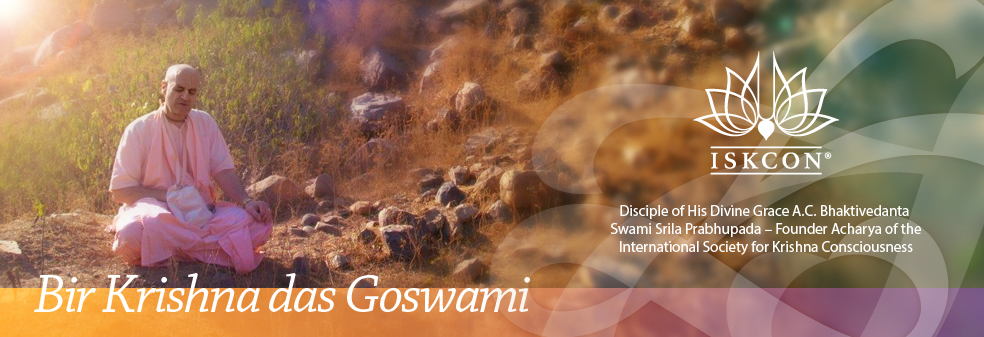EC Realizations – Govardhan – July 26, 2008
There were many wonderful realizations that the participants in the Empathic Communication seminar had, but before describing the seminar per se I would like to delve into some personal realizations and experiences.
Starting with my EC seminar in Serbia, I began to realize that for most people EC (and NVC) required much practice to integrate. For example we have the four steps of connection: observation, feelings, needs, and requests; and also the four D’s of disconnection-diagnosis, denial, demand, and deserve.
People very much appreciated the workshops and seminars, but were struggling to maintain the consciousness that they had experienced.
The standard method for reinforcing this consciousness is to have groups that meet regularly. This is effective, but not always possible as people in the modern world have many commitments. I have seen that in the beginning there is much enthusiasm but it is common for people to get diverted and after some time the group dissolves.
Also, it was not my intention to form another cult-the EC cult but rather to have those who are able to integrate empathy into their lives interact with the greater world in that consciousness.
I have seen the some of the drawbacks of group behavior in this regard in the Krishna conscious movement. People are very Krishna conscious when they are associating with members of the group, but when they are with others the level of consciousness may drop. Of course association is very important, but if one uses association as a crutch rather than a source of inspiration, one may become weak.
Once in his quarters in New Dwaraka, Srila Prabhupada said, “Ultimately, we must all fly our own airplane.”
So, with these thoughts, I resolved after the first day of the Serbian seminar to find some way help people to more quickly integrate the essence of EC (or NVC).
I began to analyze the model and the methods of presenting it, and quickly came to the conclusion that the whole model was based on “needs” and everything flowed from there. In other words feelings come from needs and strategies also came from needs, and a person has ownership of his/her needs.
With this in mind I drew a chart with a big circle in the middle. In the middle were the needs (with hearts around them) and connected with needs (either directly or indirectly) was everything else in the EC (and NVC) model. Basically this chart was all that I needed to explain EC. In the beginning I also used the list of the 4 D’s of disconnection.
I used the regular outlines that I had used before for explaining the principles, along with the demonstrations and exercises too. The chart though made it really simple for people to integrate and remember.
The idea was to teach the whole process in the standard way in the beginning (using the new chart), and to gradually wean the students away from the process once they had imbibed the essence as everything would naturally follow from that. If EC (and NVC) remains a process then one ultimately loses connection with the essence.
In Krishna consciousness we have a similar concept in the sastras with the idea of ritualistically following without understanding the essence (niyamagraha). Also it is stated:
dharma-svanustitah pumsam
visvaksena kathasu yah
notpadayed yadi ratim
srama eva hi kevalam
[SB 1.2.8]
The purpose of dharma artha kama is to come to the platform of bhakti. If one does not come to that platform, simply as a matter of formula and rituals, the Bhagavata says, it is simply waste of time. Srama eva hi kevalam. (from a class given by Srila Prabhupada)
In Croatia we had so many devotees who were enthusiastic to sign up for the course that we had to divide our workshop into three sections: 1. Those who hoped to be teaching soon, 2. Those who had a basic understanding and wished to progress further, and 3. Those who were taking the course for the first time.
I took the prospective teachers, Gaura Nandini took the second group, and Vamandev took the third.
I started off having the students teach the basics to the other members of the group, but I could see that our main need was to further integrate the mood of compassion in a dynamic way, so in mid seminar we switched to experiencing and giving empathy by connecting with needs from which everything else springs.
It was gratifying to see how quickly empathy became an integral part of the participants’ consciousness.
In fact the realizations were so deep that some of the participants were experiencing and expressing empathy towards Krishna’s parts and parcels that were in non-human forms. Some connected to the needs and feelings of birds. Even one participant connected with a blade of grass.
I equated this to St. Francis of Assisi’s realizations. He saw everything in the universe in relation to God and addressed nature’s creations as Brother tree, Brother bird, and so on. Saint Francis’s attitude, Prabhupada explained, was first-class God consciousness.
In the Isopanisad it is stated: Yas tu sarvani bhutani atmani eva anupasyati sarvesu bhutesu cha atmanam ato na vijugupsate. “A person who observes everything in relation with the Supreme Lord and all entities as His parts and parcels and see the Supreme Lord within everything, does not never hate anything or entity.”
He connects with everyone as Krishna’s parts and parcels (brothers and sisters), understanding that the souls in this world are struggling to reconnect with Krishna but for the most part they not recognizing this ultimate need. In other words every living entity needs to connect (or reconnect as the case may be) with Krishna. All their needs are expressions of this one need (connection with Krishna).
Comments are closed. Please check back later.




Comments are closed. Please check back later.